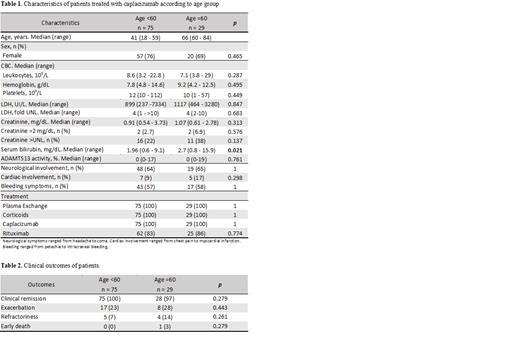Introduction
Immune thrombotic thrombocytopenic purpura (iTPP) is a rare microangiopathic thrombotic disorder with severely reduced levels of ADAMTS13 due to the presence of autoantibodies. It has classically been treated with plasma exchange (PEx) therapy and steroids, with the introduction of novel therapies in recent years such as rituximab and caplacizumab. Data concerning caplacizumabs' efficacy and safety profile in elderly patients is scarce, as iTTP is rarely presented in this population. We aimed to compare response to treatment with caplacizumab as well as safety, and tolerability in patients ≥60 years compared to those aged <60.
Mat&Met
Data were obtained from the Spanish TTP Registry. Patients were eligible if the diagnosis of iTTP was confirmed by ADAMTS13 activity <20%, presence of anti-ADAMTS13 autoantibodies, and had received caplacizumab at any time during the acute episode. Response criteria were defined following the revised criteria published by the International Working Group (Cucker et al. 2021). Statistical analysis was performed using EzR software, based on R commander (R Commander Version 2.6-1).
Results
A total of 104 patients from 39 centers, diagnosed from November 2018 to April 2023 were included (93 first episodes and 11 relapses). Twenty-nine patients (28%) were ≥60 years (Group 1) and 75 were <60 years (Group 2). Main characteristics of these patients are detailed in Table 1. Front-line treatment consisted of PEx and steroids in every patient, while rituximab was administered in 84% of patients. Caplacizumab was administered at a median (range) of 3 days (0-26) after diagnosis in patients <60 years and 5 days (0-23) in patients ≥60 years ( P= n.s.). Caplacizumab was administered as front-line therapy (n=21), after an exacerbation (n=5) or due to refractoriness (n=3) in the cohort of patients ≥60 years, and this occurred in a similar proportion in patients <60 years (58, 12 and 5, respectively; P= n.s.). The duration of treatment with caplacizumab was 34 (range, 1-77) and 35 days (range, 1-188) in patients ≥60 and <60 years, respectively ( P= n.s.).
Final outcomes are detailed in Table 2. One patient ≥60 years died due to refractory disease despite starting caplacizumab during the first 24h after diagnosis Three of the 21 patients receiving caplacizumab as front-line treatment in Group 2 suffered an exacerbation (two due to treatment discontinuation and one while receiving caplacizumab).
In 5/29 patients in Group 2, therapy with caplacizumab was delayed due to initial hemorrhagic symptoms (n=3) or ongoing anticoagulation or antiaggregation (one each). Bleeding motivating transient caplacizumab discontinuation occurred in five patients (17%) (subarachnoideal hemorrhage [one patient], hematuria, and pericatheter hemorrhage [one patient], abdominal hematoma, gastrointestinal, and gingival hemorrhage [one each]), and this was more frequent than in younger patients (one case of rectal bleeding [1.3%], P= .006). No other side-effects were reported.
Conclusion
Association of caplacizumab to PEx and immunosuppressive therapy improves outcomes in elderly patients with iTTP, although relevant bleeding complications might be higher than in younger patients.
Disclosures
De La Rubia:Janssen: Honoraria, Speakers Bureau; GSK: Honoraria, Research Funding, Speakers Bureau; Pfizer: Speakers Bureau; Sanofi: Speakers Bureau; Takeda: Research Funding; Menarini: Honoraria; Oncopharm: Honoraria; BMS: Honoraria.


This feature is available to Subscribers Only
Sign In or Create an Account Close Modal